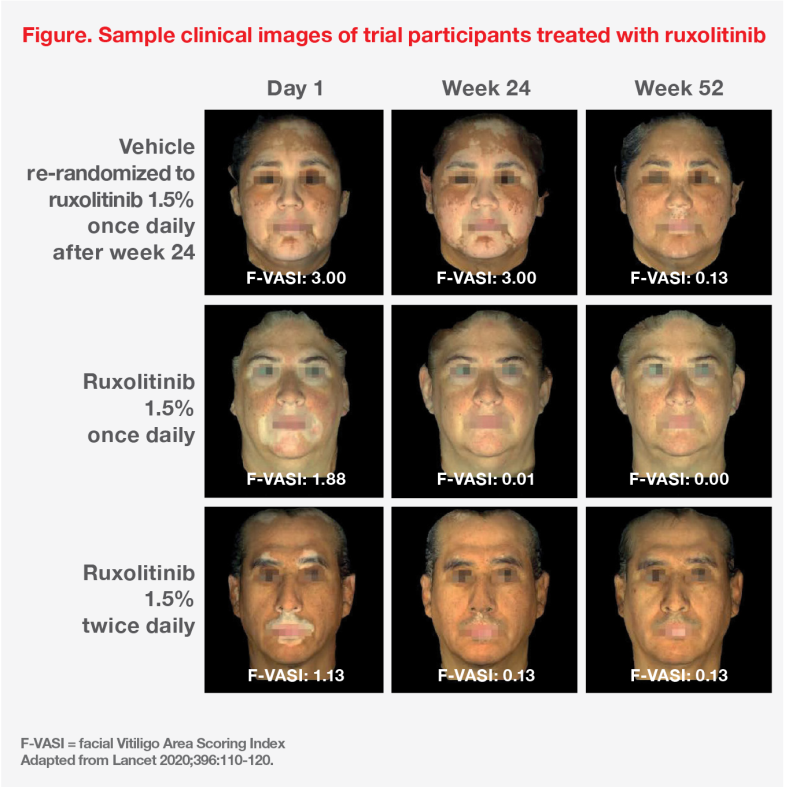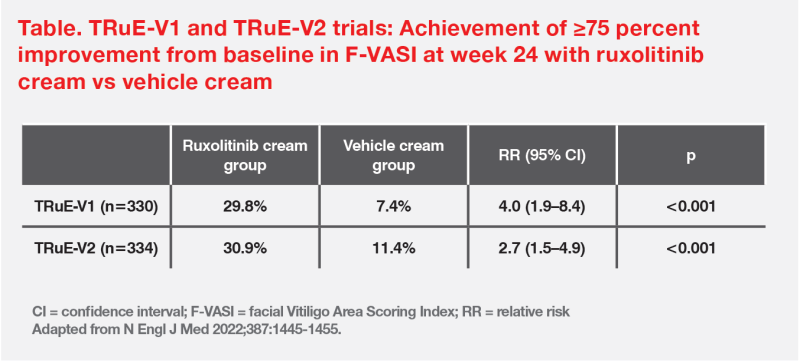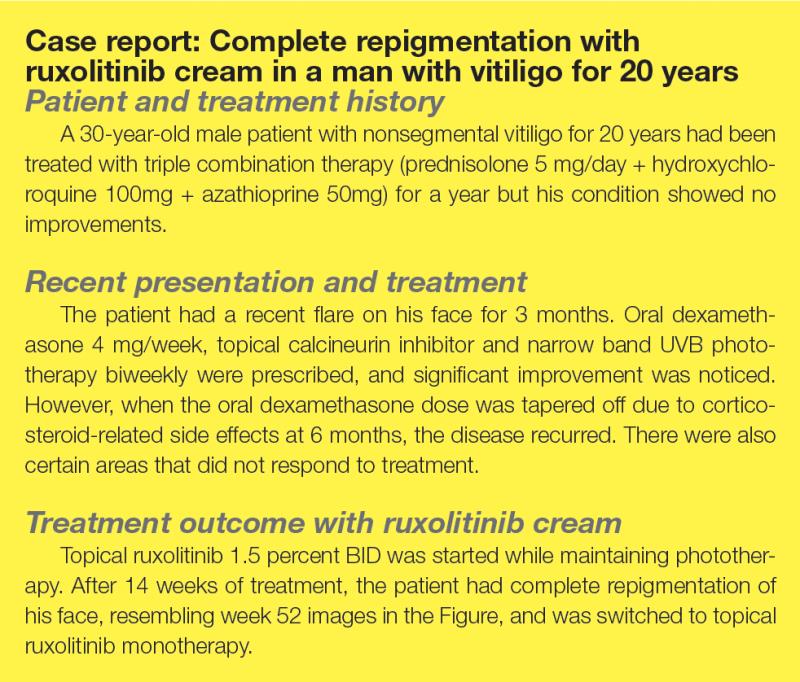Ruxolitinib: The first and only US FDA–approved topical repigmentation treatment for vitiligo





Vitiligo, a chronic autoimmune condition characterized by skin depigmentation, significantly impacts patients’ quality of life (QoL) and psychosocial well-being. At a symposium held during the Advances in Medicine (AIM) 2025 conference, Dr Chau-Yee Ng of the Vitiligo Clinic and Pigment Research Center, Chang Gung Memorial Hospital, Taipei, Taiwan, shared latest advances in vitiligo research, highlighting US FDA’s approval of ruxolitinib cream (Lumirix®, Rxilient Medical), the first topical Janus kinase (JAK) inhibitor designed to target repigmentation in vitiligo.
A challenging disease
Vitiligo is an autoimmune disorder affecting approximately 1–2 percent of the global population. The typical white patches caused by loss of skin pigmentation can lead to significant emotional distress. [Cureus 2023;15:e45030]
Vitiligo is often associated with other autoimmune conditions, commonly Hashimoto’s thyroiditis, with a higher risk in individuals with larger affected body surface area (BSA) and longer disease duration. [Br J Dermatol 2013;168:756-761]
“The condition is characterized by subtle disease activity and a prolonged, unpredictable clinical course,” noted Ng. “Recovery with treatment can be prolonged. Thus, photographic documentation with polarized and wood’s light source is crucial for monitoring treatment effectiveness, tracking disease activity and potential repigmentation.”
Pathogenesis of vitiligo
The development of vitiligo is linked to a combination of genetic predisposition and environmental triggers, such as skin friction and trauma, chemical exposure, ultraviolet (UV) irradiation, and infections. Damage to melanocytes due to oxidative stress triggers an autoimmune response. This leads to destruction of melanocytes by CD8+ T-cells, which causes depigmentation and appearance of white patches. Interferon (IFN)-γ released in the process further attracts more autoreactive T-cells, exacerbating the condition. In addition, interleukin (IL)-15 is an important cytokine that sustains resident memory T-cells, which contribute to progression and maintenance of vitiligo. [Dermatol Sin 2023;41:133-144; Annu Rev Immunol 2020;38:621-648]
“IFN-γ plays a critical role in the pathogenesis of vitiligo, and it signals through the JAK1/JAK2/STAT pathway,” explained Ng. “In addition to recruitment of autoreactive T-cells, IFN-γ also exerts direct cytotoxic effects on melanocytes. Hence, it is an important therapeutic target for vitiligo treatment. JAK inhibitors have emerged as a unique class of drugs as they target both IFN-γ and IL- 15.” [Dermatol Sin 2023;41:133-144; Annu Rev Immunol 2020;38:621-648]
Ruxolitinib: A significant breakthrough in vitiligo treatment
Ruxolitinib, a topical inhibitor of JAK 1 and 2, is indicated for treatment of nonsegmental vitiligo with facial involvement in patients ≥12 years of age. It is the first and only US FDA—approved treatment for skin repigmentation in vitiligo. [Lumirix Hong Kong Prescribing Information; https://www.fda.gov/ drugs/news-events-human-drugs/ fda-approves-topical-treatment-addressing-repigmentation-vitiligo-patients-aged-12-and-older] Of note, monobenzone, the other US FDA– approved topical treatment for vitiligo, permanently depigments normal skin surrounding vitiliginous lesions. [https:/www.accessdata.fda.gov\/drugsatfda_docs/label/2003/08173slr015_benoquin_lbl.pdf]
In a randomized, double-blind, phase II study, ruxolitinib monotherapy demonstrated effective and sustained repigmentation in adults (n=157) with vitiligo. A significantly higher proportion of patients who applied 1.5 percent ruxolitinib cream QD or BID had a ≥50 percent improvement from baseline in facial Vitiligo Area Scoring Index (F-VASI) score at week 24 vs vehicle (QD: 50 vs 3 percent; odds ratio [OR], 28.5; 95 percent confidence interval [CI], 3.7–1,305.2; p<0.0001) (BID: 45 vs 3 percent; OR, 24.7; 95 percent CI, 3.3–1,121.4; p=0.0001). Continuous improvement was seen through 52 weeks of therapy. (Figure) [Lancet 2020;396:110-120]

Two phase III, randomized controlled trials of ruxolitinib cream (TRuE-V1 [n=330] and TRuE-V2 [n=334]) in patients ≥12 years of age with nonsegmental vitiligo confirmed the results of the phase II study. In TRuE-V1, a significantly higher proportion of patients in the ruxolitinib monotherapy vs vehicle cream group achieved ≥75 percent improvement from baseline in F-VASI at week 24 (29.8 vs 7.4 percent; relative risk [RR], 4.0; 95 percent CI, 1.9–8.4; p<0.001) vs the vehicle cream group. Similar findings were reported in TRuE-V2 (30.9 vs 11.4 percent; RR, 2.7; 95 percent CI, 1.5–4.9; p<0.001). (Table) [N Engl J Med 2022;387:1445-1455]

Ruxolitinib cream was well tolerated, and application site reactions were mild or moderate, with acne and pruritus at the application site being the most common adverse events. [N Engl J Med 2022;387:1445-1455]
“I have personally witnessed such impressive results in my practice,” said Ng. (Case report)

“Epidermal concentration of ruxolitinib after topical application is considerably higher [approximately 2,000-fold] than after oral administration, while plasma concentration remains much lower [approximately one-thirtieth]. This localized delivery provides targeted treatment of skin with a reduced risk of systemic side effects,” added Ng. [Int J Pharm 2020;590:119889]
Treatment recommendations
Depending on the subtype (segmental vs nonsegmental), disease activity, and extent of melanocyte destruction, various topical and systemic treatments, phototherapy, and surgical interventions are used to halt disease progression and facilitate repigmentation in patients with vitiligo.
The Taiwanese Dermatological Association recommends topical corticosteroid, topical calcineurin inhibitor and topical ruxolitinib as first-line treatment options for nonsegmental vitiligo with limited treatment area (≤10 percent BSA) in patients ≥12 years of age. For active and rapidly progressive vitiligo, systemic immunosuppressant therapy (eg, dexamethasone 2.5–5 mg oral mini-pulse regimen on 2 consecutive days per week) is recommended with concomitant phototherapy and topical treatment. [Dermatol Sin 2025;43:14-25]
“Once the condition is stabilized, treatment should focus on repigmentation,” noted Ng. “This can be achieved via phototherapy with 311 nm narrow-band ultraviolet B [NB-UVB], excimer light treatment, and/or grafting procedures. Patients without access to phototherapy may benefit from 15 minutes of moderate sun exposure, preferably before 9 am or after 4 pm, while protecting surrounding healthy skin with sunscreen.” [J Invest Dermatol 2015;135:2068-2076; Dermatol Sin 2025;43:14-25; Dermatol Sin 2023;41:133-144]
Repigmentation is a slow process
Repigmentation involves regeneration and migration of melanocytes from healthy skin to the affected areas. Two common patterns of repigmentation are perifollicular and marginal. In peri-follicular repigmentation, melanocyte precursors in the hair follicle bulge proliferate, migrate, and differentiate into mature melanocytes, which then repopulate the depigmented skin. Marginal repigmentation pattern results from inward migration of melanocytes present in the perilesional epidermis. [Indian J Dermatol 2009;54:313-318; J Invest Dermatol 2015;135:2068-2076]
Restoring skin pigmentation can take weeks to months, depending on lesion location. Pooled analyses of the TRuE-V1 and TRuE-V2 trials showed that a substantial percentage of patients applying ruxolitinib cream achieved meaningful repigmentation across body regions after 52 weeks of treatment. [J Eur Acad Dermatol Venereol 2025;39:e251-e254]
“Repigmentation relies on a viable melanocyte reservoir,” explained Ng. “If melanocytes are completely absent or destroyed [presence of white hair (poliosis), and hairless areas especially in acral regions], it may not be possible to induce repigmentation using topical or systemic medications, or phototherapy. In such cases, surgical grafting may be necessary to restore skin colour. Hence, it is crucial to set realistic expectations to avoid dissatisfaction and disappointment with treatment outcomes.” [Indian J Dermatol 2009;54:313-318; Br J Dermatol 2013;168:1143-1146]
Last thoughts
“Vitiligo is treatable and it’s best to treat it at an early stage. We should help patients detect vitiligo early and at least stop the disease from progressing before the damage becomes permanent,” said Ng.
Effective vitiligo treatment requires a tailored, personalized approach that considers disease activity, type, and the degree of melanocyte destruction. US FDA’s approval of ruxolitinib cream, the first topical JAK inhibitor for skin repigmentation in nonsegmental vitiligo, marks a significant milestone in vitiligo treatment.